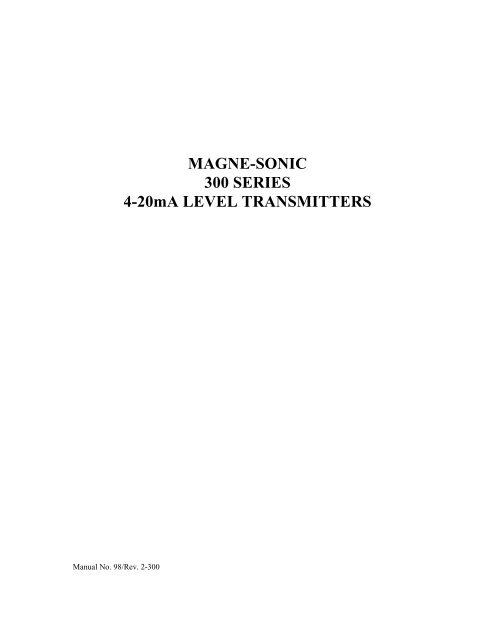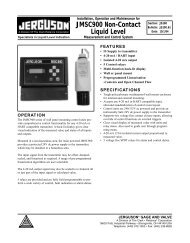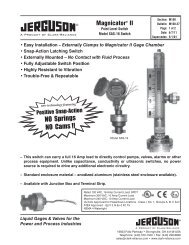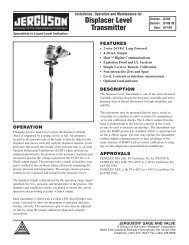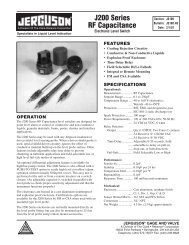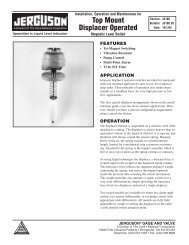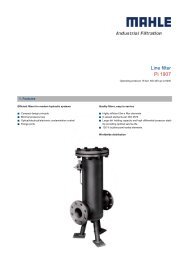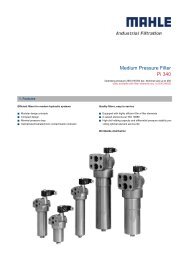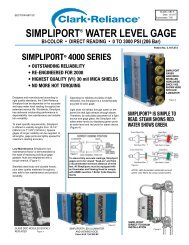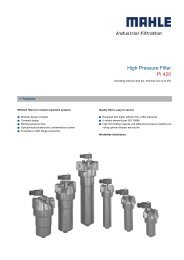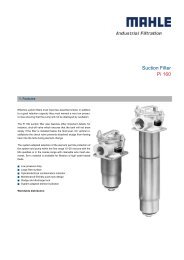MAGNE-SONIC 300 SERIES 4-20mA LEVEL ... - Clark Reliance
MAGNE-SONIC 300 SERIES 4-20mA LEVEL ... - Clark Reliance
MAGNE-SONIC 300 SERIES 4-20mA LEVEL ... - Clark Reliance
Create successful ePaper yourself
Turn your PDF publications into a flip-book with our unique Google optimized e-Paper software.
Manual No. 98/Rev. 2-<strong>300</strong><strong>MAGNE</strong>-<strong>SONIC</strong><strong>300</strong> <strong>SERIES</strong>4-<strong>20mA</strong> <strong>LEVEL</strong> TRANSMITTERS
TABLE OF CONTENTSPART ONE - INTRODUCTIONSECTION 1SECTION 2GENERAL INFORMATION1.1 Description1.2 Product IdentificationSPECIFICATIONSPART TWO - INSTALLATIONSECTION 1SECTION 2SECTION 3UNPACKINGMECHANICAL REQUIREMENTS2.1 Location2.2 Integral Mounting2.3 Remote MountingELECTRICAL CONNECTIONS3.1 AC Line Powered3.2 DC PoweredPART THREE - OPERATIONSECTION 1SECTION 2OPERATING CONTROLS1.1 Calibration1.2 Output Mode1.3 Output DampingCALIBRATION2.1 With Output in Direct Acting Mode2.2 With Output in Reverse Acting ModePART FOUR - PRINCIPLE OF OPERATION
PART FIVE - SERVICE & MAINTENANCESECTION 1SECTION 2GENERALCUSTOMER ASSISTANCEPART SIX - SPARE PARTS & ACCESSORIESILLUSTRATIONS:Figure 2-1Figure 2-2Figure 2-3Figure 2-4Figure 2-5Figure 2-6Figure 2-7Figure 3-1Figure 4-1Typical Installation LocationsIntegral MountingRemote MountingLevel Probe Hook-upAC Line Power Hook-upDC Power and Output Hook-upDC Power (24VDC Two Wire)Control Panel LayoutInstrument Operations Schematic
PART ONE - INTRODUCTIONSECTION 1 - GENERAL INFORMATION1.1 Description The Series 310 RF electronic level transmitter is designed forcontinuous level measurement of conductive and nonconductiveliquids, granular materials, slurries and interfaceapplications. It can be used with any Magne-Sonics bare orinsulated level sensing probe.Anti-CoatingOutput FlexibilityThe instrument contains special "anti-coat" circuitry tocompensate for the effect of conductive coating which maybuild up on the level sensing probe surface.The transmitter provides a 4-<strong>20mA</strong> isolated output withadjustable damping. The unit may be field selected for direct orreverse acting output modes.1.2 Product The serial number of your instrument is located on theIdentification electronic chassis next to the power input terminals. Write theserial number in the space provided below for convenientidentification should technical assistance be required.Serial # ___________________________________
SECTION 2 - SPECIFICATIONS2.1 Operational Display NoneAmbient Conditions........ -40 to 160°F (-40 to 71°C), 0 to 95%relative humidity, non-condensingPower Requirements:AC Line Powered...... 115 or 230 VAC, 50/60 Hz.DC Powered.............. 18 to 35 VDCLevel Probe toTransmitter Distance....... 150 feet maximum (when Series 310is remote mounted)Analog Output................Isolated 4-<strong>20mA</strong>, field selectabledirect or reverse actingOutput Load:AC Line Powered...... 600 ohms max. loadDC Powered.............. 550 ohms max. load @ 24 VDC; forhigher loads R=50 (V-13)Output Damping.............Adjustable, 0.1 to 10 secondsAnti-Coat Circuitry......... Phase shift type; compensatesautomatically for conductivecoatingsProtection........................ RFI, EMI and static charge2.1 Performance Zero Adj. Range.............. 0 to 500 pFSpan Adj. Range.............. 10 to 10,000 pFZero/Span Ratio.............. 10:1 maximumLinearity.......................... 0.5% of full scale
Temp. Stability............... Greater of 0.01 pF per °F or 0.01%of span per °F2.3 Mechanical EnclosureStandard.................... Cast aluminum finish w/urethanefinish - NEMA 4, 7 BCD and 9 EFG(weatherproof, hoseproof, dust andvapor explosion proof)Optional.................... PVC - NEMA 4X for corrosive areasNet Weight................ 3.6 lbs. (1.63 kg)
PART TWO - INSTALLATIONAfter unpacking, open the transmitter enclosure and inspect theelectronic chassis for shipping damage. If there is evidenceof damage, notify the carrier immediately. Save the smallplastic screwdriver and banana plug for later use.SECTION 2 - MECHANICAL REQUIREMENTS2.1 Location Mounting positions for the level probe should be carefullyconsidered. The probe must be installed vertically and itslength must be sufficiently long to handle the entire measuringrange. Do not locate the level probe in a position where theinflow of measured material could contact it. Also, locationsshould be well clear of obstructions and agitators. Figure 2-1illustrates typical mounting locations.Note!: When measuring the level of a non-conductive materialin an irregularly shaped vessel, the output will be nonlineardue to the varying distance between the levelprobe and the vessel wall. In this case, mount the probein a grounded metal standpipe or use a concentricshield level probe to linearize the output. This is notnecessary if the measured material is conductive andgrounded.Figure 2-1 Typical Level Probe/Transmitter Locations
Level probes used in granular materials should be locatedhalfway between the vessel wall and the apex of the materialpile created by the incoming material. The output will then berepresentative of the average level.For applications involving a vessel with non-conductive walls,a ground reference plate or grounded reference level element isrequired. However, if the measured material is conductive andgrounded, this is not necessary.The Series 310 may be installed directly onto the level probe(integral mounting) or in a remote location up to 150 feet fromthe level probe.Note!: Remote mounting is necessary when the temperature atthe Series 310 exceeds its rated specification (-40 to160°F) or if severe vibration exists. Triaxialinterconnect cable must be used for remote mounting.The DC powered Series 310 is housed in a cast aluminumweatherproof and explosion proof enclosure allowing it to belocated in Class I or II, Division 1 hazardous areas.2.2 Integral The Series 310 has 1/2 inch NPT hole on the bottom center ofMounting the enclosure for direct mounting onto the installed level probe.To install the level probe and the Series 310:1. Install level probe into vessel opening without the Series310 mounted on it. Use a wrench on the larger lower hexnut portion only of the two piece fitting to tighten levelprobe into vessel.CAUTION!: Do not tighten or loosen the smallerupper hex nut portion of the two piecefitting. This is a compression seal thatcould be destroyed if the upper portion isturned.
Figure 2-2 Integral MountingIf level probe is welded into a mounting flange, simply boltflange to the mating flange on the vessel.2. Install banana plug onto back end of level probe extensionby screwing it into the threaded hole.asCAUTION!: Do not tighten plug with excessive forceit can be easily twisted off.3. Carefully screw the Series 310 enclosure onto threadedupper portion of fitting on back end of level probe. Thebanana plug makes the necessary electrical connection tothe electronic chassis. Screw until tight, but withoutexcessive force to avoid stripping the aluminum threads.Note!: It may be necessary to rotate enclosure to orientwiring entrances to a desired position. Use awrench to hold the upper smaller hex nut stationarywhile turning the enclosure.2.3 Remote An explosion proof junction box, which mounts onto the levelMounting probe, and triaxial interconnect cable are required to remotemount the Series 310. An optional remote-mount threadedadapter is also required to remote mount the Series 310.
1. Install level probe into vessel opening or flange mountingas previously described in Section 2.2, step 1.2. Screw explosion proof junction box onto threaded upperportion of fitting on back end of level probe. The same"CAUTION" regarding the compression seal that'sdescribed in Section 2.2 - step 1 applies here whentightening and orienting junction box onto top of levelprobe.3. Remote mount the Series 310 in as clean and dry a locationas possible where minimal mechanical vibration exists.Avoid locations where corrosive fluids may fall on theinstrument or where ambient temperature limits (-40 to160°F, -40 to 71°C) may be exceeded.A. Blind Style Model1. Install remote mount threaded adapter into 1/2 inchNPT hole in bottom of enclosure casting.Note!: The adapter must be solid fitting to preservethe explosion proof rating of the enclosure.(Should adapter become lost, do not use apipe nipple in explosion proof applications.Also, use only approved explosion proofwiring seal fittings - not provided - inconduit entrance holes).2. Surface mount the Series 310 with the remotemount threaded adapter within 150 feet of theinstalled level probe.Figure 2-3 Remote Mounting
SECTION 3 - ELECTRICAL CONNECTIONS3.1 AC Line PoweredLevel ProbeIntegral Mounted ProbeConnect level probe to Series 310 via the banana plug installedonto back end of probe. The plug must be securely fastened andnot damaged.Remote Mounted ProbeUse only triaxial interconnect cable (P/N 1000-3073 for up to160°F; P/N 1000-3074 for up to 392°F) to connect junctionbox terminals to Series 310. Any other type causes incorrectinstrument operation. Refer to Figure 2-4 and connect triaxialcable, matching wires to terminals as follows:Triaxial Cable WiresCenter wireBlue wire (inner shield)Green wire (outer shield)Terminal DesignationsPROBESHIELDGround symbolFigure 2-4 Level Probe Hook-up
Line PowerLine power requirements may be 115 VAC or 230 VACdepending on the model selected. Check which voltage iscorrect for the unit being installed. Refer to Figure 2-5 andconnect line power to terminals designated "L1/HOT" and"GND" which are fuse protected. Use wiring practices whichconform to local codes (National Electrical Code Handbook inthe U.S.A.). This includes:Using wire sizes recommended by the local code for primarypower wiring.Using only the standard three wire connection for AC wiring.The ground terminal grounds the instrument which ismandatory for safe operation.Figure 2-5 AC Line Power Hook-up3.2 DC PoweredLevel Probe Integral Mounted Probe - Refer to same category in Section 3.1Remote Mounted Probe - Refer to same category in Section 3.1
DC Power andOutputWhen Using Non-Indicating Power Supply1. Refer to Figure 2-6 and connect non-indicating DC voltagepower supply to terminals designated "18-35 VDC",matching polarity as shown.2. Connect indicating device to terminals designated "4-<strong>20mA</strong>OUTPUT", matching polarity as shown. This isolatedoutput can drive a load up to 550 ohms @ 24 VDC.Figure 2-6 DC Power and Output Hookup - Blind StyleDC Power (24VDCTwo Wire)When Using Non-Indicating Power Supply1. Refer to Figure 2-7 and connect non-indicating DC voltagepower supply to terminals designated “18-35 VDC”,matching polarity as shown.Figure 2-7 24VDC Two Wire (Loop Powered)
PART THREE - OPERATIONSECTION 1 - OPERATING CONTROLSAll controls used for setup and operation are described in thissection. Familiarize yourself with each item before operatingthe instrument. Use the small plastic screwdriver provided tomake control adjustments. Do not force any adjustment past itsstops to avoid breakage.1.1 Calibration 1. ZERO COARSE switchPositions 0 through 9 progressively add 50 pF to theZERO FINE control (item 2) adjustment. This switch isused in combination with the ZERO FINE control toestablish the output signal.2. ZERO FINE controlSets the exact zero level to 4 mA output. The range ofadjustments is 60 pF in 40 turns.Caution!:Do not force this 40 turn control past itsadjustment stops to avoid breakage.3. SPAN COARSE switchPositions 1 through 6 progressively changes the total spanfrom a minimum of 0-10 pF to a maximum of 0-10,000 pF.This switch is used in combination with the SPAN FINEcontrol (item 4) to establish the total span.4. SPAN FINE control1.2 Output Mode 5. REV/DIR switchSets the exact 100% level to 20 mA output. The range ofadjustment is 30 turns.
Selects output to be direct (DIR) or inverted (REV):1.3 Output Damping 6. RESP controlDIR - Output increases from 4 mA to 20 mA as measuredlevel rises.REV - Output decreases from 20 mA to 4 mA as measuredlevel rises.Dampens output signal via an RC time constant circuitfrom 0.1 to 10 seconds by turning clockwise (270°rotation).Figure 3-1 Control Panel Layout - Blind Style
SECTION 2 - CALIBRATION2.1 With Output in DirectActing ModeSetting Zero Level OutputWith material at the desired low level (0% full) on the levelsensing element:1. Connect a milliamp meter to the Series 310 to monitor the4-<strong>20mA</strong> loop current:A. Connect milliamp meter with test leads to "TEST" jackslocated on control panel, matching polarity as indicated.B. Connect a load across - or short together - the "4-<strong>20mA</strong>OUTPUT" terminals. See Part One, Section 2specifications for maximum allowable load resistance.Note!:If the milliamp meter resistance is more than25 ohms, disregard steps 1 and 2. Instead,connect the milliamp meter in series with aload across the "4-<strong>20mA</strong> OUTPUT"terminals. Do not exceed maximumallowable resistance.2. Place the following controls and switches to these settings:ControlSettingZERO COARSE switch................ 0ZERO FINE control..................... Fully counterclockwiseSPAN COARSE switch................ 1SPAN FINE control...................... Fully counterclockwiseREV/DIR switch........................... DIRRESP control................................. Fully counterclockwiseCaution!: The ZERO FINE control is a glasscomponent. To avoid breakage, do not forceit past its 40 turn adjustment stops.
Note!: The SPAN FINE control does not have adjustmentstops. To set it to the end of its travel, slowly turncounterclockwise (left) until a "soft clicking" soundis heard while turning.3. Apply power to the instrument. The milliamp meter readingshould be 20 mA or higher.4. Increase ZERO COARSE switch setting in clockwisesteps until the milliamp meter reads 4 mA or lower. Thenturn switch back (counterclockwise) one position step. Theoutput should increase to 20 mA or higher again. LeaveZERO COARSE switch at this setting. If switch is atposition 9 and output is not yet at 4 mA or lower, leave atsetting 9.5. Turn ZERO FINE control slowly clockwise (right) untilthe milliamp meter reads exactly 4 mA. This is the outputat 0% full level. Leave ZERO FINE control at this setting.If output cannot be adjusted to 4 mA, the zero adjustmentrange has been exceeded. Consult factory for assistance.Setting The FullLevel Output1. Change SPAN COARSE switch setting from 1 to 6 andSPAN FINE control setting from fully counterclockwise tofully clockwise (approximately 30 turns).2. Manually raise the measured material level up to thedesired "full level" position on the level sensing element.The milliamp meter reading should be less than 20 mA. Ifthe reading is higher than 20 mA, the measuring elementhas produced a capacitance change greater than themaximum span of the instrument. This is unlikely, exceptin cases where the measuring element is very long andsubmerged in conductive material.Note!: If the material level cannot be raised up to thedesired full level position, refer to the "specialcase" box on the next page for instructions.3. Decrease SPAN COARSE switch setting incounterclockwise steps until the milliamp meter readshigher than 20 mA. Then turn switch forward (clockwise)one position step. The output should decrease below 20 mAagain. Leave SPAN COARSE switch at this setting. If
switch is at position 1 and output is still below 20 mA,leave at setting 1 and proceed with step 4.4. Turn SPAN FINE control slowly counterclockwise (left)until the milliamp meter reads exactly 20 mA. This is theoutput at 100% full level. Leave SPAN FINE control atthis setting. If output cannot be adjusted to 20 mA, thecapacitance change produced by the level element is lessthan the minimum measurement span. Consult factory forassistance.The instrument is now calibrated.SPECIAL CASE FOR SETTING FULL <strong>LEVEL</strong> OUTPUTIt may not be possible to raise the material level up to thedesired "full level" position due to lack of sufficient material. Inthis case:A. Bring as much material into the vessel as possible. Thencalculate the standing level as a percentage of the total levelspan and convert this value to mA on a 4-20 mA scale.B. Perform steps 3 and 4 exactly as previously describedexcept using the appropriate calculated mA value instead of20 mA (12 mA for this example).Note!:Calibration using less than a 25% full span levelchange is not recommended. It may be necessary torecalibrate the full level at a later time when the vesselis fullAdjusting OutputSignal DampingOutput damping is provided to damp a constantly changingoutput signal caused by turbulent material level. Turning theRESP control clockwise (right) increases the damping from 0.1to 10 seconds. Turn this control slowly clockwise until anyoutput ripple is no longer evident.2.2 With Output in
Reverse ModeThe switch and control settings described in Section 2.1 areexactly the same except set the REV/DIR switch to the REVposition.The calibration procedure is exactly the same as in the directacting mode except that 20 mA is substituted for 4 mA and 4mA is substituted for 20 mA wherever referenced.PART FOUR - PRINCIPLE OF OPERATION
See Figure 4-1 for a simplified schematic diagram pertaining tothese descriptions:1. The power supply section (not shown) converts line powerto appropriate voltages for circuit operation.2. The OSCILLATOR section produces the triangle wavesignal used to measure the probe impendance and severalsquare wave signals used to synchronize other parts of thecircuit.A voltage controlled square wave oscillator operates at afrequency four times that of the measuring signal. Two"flip-flops" divide the oscillator frequency and producefour square waves with a 90° phase difference betweeneach successive signal. One of these square waves isapplied through a resistor to a capacitor. The result, a lowvoltage triangle wave with low distortion, becomes theSHIELD signal.Figure 4-1 Instrument Operations Schematic DiagramThe SHIELD signal is gated with analog switchescontrolled by two of the square wave signals to adifferential amplifier which produces an output voltageproportional to the peak-to-peak voltage of the SHIELDsignal. This voltage is compared to a reference voltage by
another differential amplifier which produces an outputvoltage that is used to adjust the frequency of the voltagecontrolled oscillator. If the SHIELD voltage is too low, theamplifier output increases. This increases the period of thesignal which allows the capacitor to charge to a highervoltage. The reverse occurs if the voltage is too high. Thisfeedback circuit maintains a constant SHIELD signalvoltage and compensates for any circuit drift and for anycapacitance at the SHIELD terminal from any cableconnected there.3. In the DETECTOR section, the SHIELD signal voltage isamplified and applied to an adjustable ZERO capacitorwhich is connected to the PROBE terminal. The probeforms a variable capacitor to ground. A large adjustableSPAN capacitor is connected between the PROBE andSHIELD terminals. Since the impendance of the SPANcapacitor is much lower than that of the ZERO or PROBEcapacitors, the voltage on the PROBE terminal isapproximately equal to the voltage on the SHIELDterminal. When the ZERO and PROBE capacitors areequal, no current flows through the SPAN capacitor. As thePROBE capacitance increases due to increasing level in thevessel, current through the SPAN capacitor increases. Thiscurrent produces a very small voltage across the capacitorwhich is transformer coupled to the input of a high gainamplifier.The output of the amplifier is gated by analog switches to adifferential amplifier which produces a voltage proportionalto the capacitance difference. The harmonic content of thetriangle wave signal and the operation of the analogswitches allow the circuit to ignore the effect of probebuildup. The differential amplifier includes a FINE SPANadjustment which controls its gain.4. The OUTPUT section includes an adjustment to vary theunit's response time to allow it to produce a steady outputsignal level even when there is turbulence in the vessel. Aswitch controls whether or not the resulting signal isinverted before being converted to an output current. If thesignal is not inverted, the output is direct acting and will
increase with rising level. If inverted, the output is reverseacting, (decreases with rising level).PART SIX - SPARE PARTS & ACCESSORIESDescriptionPart NumberAccessories for Threaded Adapter (blind style)............... 1000-3071Remote MountingExplosion Proof J-Box(with jack and terminal strip).................. 1000-3072Triaxial Interconnect Cable*(for temperatures up to 160°F)............... 1000-3073Triaxial Interconnect Cable*(for temperatures up to 450°F)............... 1000-3074*Cable has stripped and tinned wires at each end. It connectsthe Series 310 to level probe j-box. Specify length up to 150feet.Electronic ChassisAssembliesBlind Style DC Powered(18-35 VDC).......................................... 690-7005-101Blind Style 115 VAC(four wire).............................................. 690-7005-201Blind Style 230 VAC(four wire).............................................. 690-7005-401Fuse1/4 Amp Slo-blow Fuse.......................... 99X1F1036


